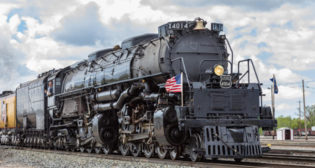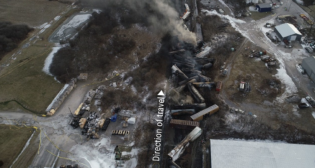
Freight Fundamentals Across All Modes Are Strong: Cowen
Written by William C. Vantuono, Editor-in-Chief
Jason Seidl
COWEN AND CO. GLOBAL TRANSPORTATION & SUSTAINABLE MOBILITY CONFERENCE TAKEAWAYS: “Railroads are focused on adding back traffic at high incremental margins, though rail network congestion persists,” Cowen and Co. analysts Jason Seidl (Managing Director and Railway Age Wall Street Contributing Editor), Matt Elkott and Adam Kramer reported following presentations by several major carriers. “Freight fundamentals across all modes are strong, with retail and CPG (consumer packaged goods) restocking of inventories a major driver of the current spike in demand. Many customers are choosing to renegotiate TL (truckload) contracts early as spot rates just eclipsed 2018 peak levels and are likely headed higher.”
HIGHLIGHTS
KANSAS CITY SOUTHERN: “KCS provided 2020 guidance including EPS flat y/y, which compares favorably to our forecast for EPS to decline -4%. However, KCS’s forecast calls for a lower tax rate than expected, which accounts for slightly more than half of the difference in expected EPS. OR Guidance of 60-61% compares favorably to our 61%, and FCF guidance of $500MM is above our estimate too. KCS has reduced headcount by 16%, with much of this coming from the U.S. as it can’t reduce headcount as much in Mexico. Growth opportunities include near-shoring of supply chains to Mexico, which is likely to increase. Mexico has structural advantages including lower wage rates, transportation costs, and time of transit from Mexico compared to China. Potential new business opportunities include multi-billion dollars of investment in new petrochemical plants in the Gulf, a paper plant being built in Monterrey, and new a facility for Stanley Black & Decker that was recently announced. KCS reiterated information around its 50-year concession from the Mexican government. Should there be a change in administration, KCS believes that its tax rate could go up 2-3%. KCS noted at the outset of its presentation that it would not be addressing any of the M&A rumors. After market close yesterday, a media report said that KCS rejected a $20B (or roughly $208 per share) offer from Blackstone and GIP.”
CN: “CN is seeing intermodal (both international and domestic) volumes recovering, along with continued strength in grain and lumber. In another indication that volumes are returning, CN recalled 2,000 T&E employees and brought back 500 locomotives and 1,500 railcars into service. However, some costs will likely remain out of the system on a permanent basis, including dispatch centers that were consolidated from three to one, some shops that remain closed, and fuel costs, with CN setting a fuel efficiency record in August, the fourth consecutive record (and best in the industry). We believe that the East Coast presents an underappreciated opportunity for CN. CN’s Eastern network is underutilized, and the Class I is using the Port of Prince Rupert as its model for building out the East. The Port of Halifax and the Port of Quebec are both undergoing significant expansions, and should aid CN in taking traffic from the Port of NY/NJ. However, with an average length of haul in domestic intermodal of 1,700 miles, it likely won’t see a volume increase with trucking spot rates spiking, but eventually will see a small benefit. Finally, CN is expecting a record grain crop in 2021, above the 77 million metric tons of the 2013-2014 crop season.”
CSX: “CSX is benefiting from a strong intermodal recovery impacting both domestic and international intermodal volumes. On the domestic side, CSX began to see signs of life at the end of 2Q, with the economy starting to recover, people going back to work, and inventories needing replenishment. Since then, volumes have stayed strong, surprising CSX to the upside. On the international side, the recovery started more recently, with steamship lines trying to bring volumes into the country as quickly as possible. Management expects strength to continue into end of the year, but forecasting beyond that is easier said than done. Intermodal is currently in excess of 15% cheaper than trucking, presenting an opportunity for CSX to increase pricing when it renegotiates contracts in the coming months and next year. As CSX adds back volumes, it will likely come at high incremental margins, as CSX had ~30% additional capacity on existing train starts, pre-COVID-19.”
UNION PACIFIC: “UP reiterated its full-year and long-term guidance, and provided an update on volumes. Intermodal demand already at or near peak-season levels is a notable positive, with lumber also a bright spot, while certain bulk areas such as coal, sand, and crude remain significantly depressed. Management attributes the recent intermodal recovery to booming parcel and e-commerce business, with UP also seeing strong demand for restocking as retailers destocked during quarantine/shelter-in-place while supply chains were essentially shut. UP also added new shorter-haul traffic opportunities (in the 400-mile range) that they hadn’t historically operated in. Finally, though UP already has significant share of the cross-border traffic in Mexico, it believes that there is still a growth opportunity there. Longer-term, management said it is sticking to its 55% operating ratio (OR) target but noted that looking at OR is not always the best target to set.”
NORFOLK SOUTHERN: “NS volumes are close to pre-COVID-19 levels in merchandise. Intermodal and total volumes are now above, though coal is still well below. GTMs per T&E Employee are near all-time highs; even at their worst in 2Q, they were still well above pre-PSR levels. Additionally, train weights have increased 11% since 1Q19. NS is seeing the shift from the West Coast to the East Coast, which will be a tailwind in the long-term. However, NS is not abandoning volumes coming from the West Coast; it has new service from the Southwest to the Southeast, partnering with both UP and BNSF. 2021 capex will likely see a modest increase, with NS trying to minimize the magnitude of the increase. NS can envision a scenario where headcount in 3Q is lower than in 2Q, and management expects a y/y improvement in 3Q OR.”
Elkott On The Equipment Market

“On the rail equipment front, it was a mixed picture for the near term,” reported Matt Elkott. “While the number of railcars in storage has declined meaningfully for two consecutive months (from ~526K units in July to ~507K units in August and ~477K units in September), lease rates do not appear to have reacted yet and may require further sequential utilization improvement before they show positive signs. We expect railcar spot lease rates to bottom late this year and begin a gradual recovery in 1H21. This should be driven by three primary factors: 1. Decelerating rail traffic declines in 2H20 and a swing back to growth in 2021. 2. In the railroad industry, the resiliency of the industry-wide, far-reaching capacity rationalization by the Class I’s as part of PSR has not yet been tested in a growing traffic environment and could lead to service hiccups, something that would be a driver of equipment demand. 3. Increased scrapping within parts of the industry’s idle railcar population that are inching toward obsolescence, such as DOT-111 tank cars and certain types of grain and box cars.
“Today’s elevated idle car population is the culmination of several factors. Rail traffic has come in well below expectations for the good part of the past two years, declining ~4% in 2019 and ~11% thus far this year. Over roughly the same period, UP, NS, and KCS became the latest Class I’s to roll out PSR, which is now near full implementation industry-wide. On the railcar build front, we estimate that seven of the past 10 years represented above-replacement-demand production, fueled in part by capital deployed by financial investors unable to find better yield alternatives. The pandemic is the latest inflammatory factor to the industry’s existing wounds.
“Railcar manufacturing inquiries seem to have ticked up somewhat, but translation into orders remains in question for some builders. This is likely due in part to uncertainty about the coronavirus, the sustainability of the economic recovery, and the upcoming elections. Greenbrier was toward the less negative end of the spectrum, noting that activity in the past couple of months has been a bit less tempered than the company had expected. Even so, we would not rule out a near-term pullback in the stock given its historical volatility, recent outperformance, and the lack of an immediate catalyst.
“For Trinity, the conversations with strategic buyers the company had discussed on its 2Q earnings call could prove to be a near-term catalyst if they prove productive. Looking beyond the immediate term and election uncertainty, a railcar demand trough looks increasingly insight within the next year, something that should drive Trinity and Greenbrier stocks when book-to- bill ratios begin to improve. GATX remained cautious in its commentary. While management did not provide a specific update on lease rates, it appeared to emphasize that, despite some recent improvement in rail traffic trends and railcar industry utilization, the rail equipment environment continues to be challenging.”



